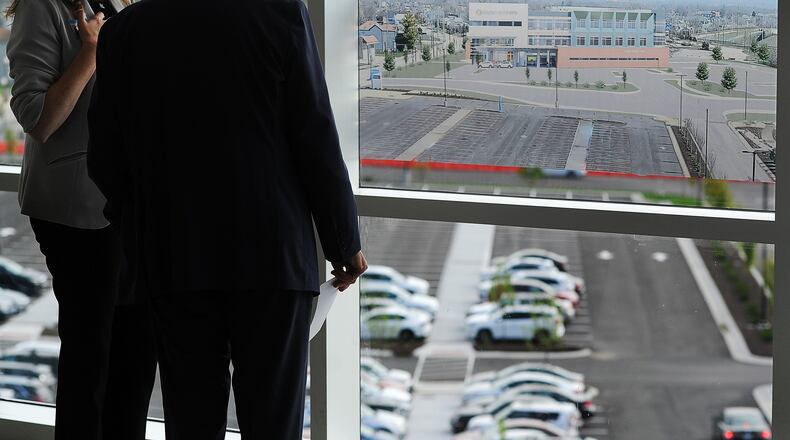“Suicide is a human tragedy, and any increase is of course deeply concerning,” said ODH Director Dr. Bruce Vanderhoff.
Death by suicide impacting youth
Suicide in 2021 was the 12th leading cause of death overall in Ohio, and was the second leading cause of death among Ohioans ages 10 to 34.
Dayton Children’s Hospital has been seeing an increase in mental concerns in children prior to the pandemic starting, and the limits on social gatherings that COVID-19 placed on people exacerbated what children were experiencing, said Dr. Mary Beth DeWitt, chief of child psychology at Dayton Children’s.
“Many children really use their peer group and that connectivity to help with their coping, and during the pandemic, we shut down some of those things, which really took a toll on a lot of our kids’ mental health,” said DeWitt.
The increases in deaths by suicide are disproportionately represented in some groups more than others. Girls, along with children who have concerns about their gender identity, tend to be affected more often, DeWitt said.
“At Dayton Children’s, we’re seeing increases in presentations to the emergency department for suicidal ideation, for depression and mental health concerns,” DeWitt said.
Over the last year, more than 7,000 children were treated for a behavioral health crisis at Dayton Children’s. There were 211 children boarded in March, waiting for a bed to become available in the behavioral health unit, which Dayton Children’s said was the highest ever and was an increase of 31% since March of last year.
Warren County sees 60% increase
Although the state saw an increase between 2020 and 2021, Warren, Butler and Preble counties were the only in the region to record higher suicide numbers for the same time period.
Warren County far exceeded the state with a more than 60% increase. The county recorded 42 deaths by suicide in 2021 compared to 26 in 2020.
Butler County, which also surpassed the state, saw eight more deaths, from 42 to 50 for a 19% increase, and Preble County recorded seven deaths by suicide in 2021, up one from 2020.
| Suicide deaths from 2017-2021 | |||||
|---|---|---|---|---|---|
| County | 2017 | 2018 | 2019 | 2020 | 2021 |
| Ohio | 1,744 | 1,836 | 1,809 | 1,642 | 1,766 |
| Butler | 52 | 50 | 53 | 42 | 50 |
| Champaign | 7 | 6 | 10 | 5 | 4 |
| Clark | 25 | 29 | 26 | 34 | 32 |
| Darke | 4 | 10 | 5 | 9 | 8 |
| Greene | 22 | 27 | 19 | 21 | 18 |
| Miami | 14 | 21 | 12 | 15 | 14 |
| Montgomery | 78 | 79 | 91 | 82 | 77 |
| Preble | 3 | 8 | 7 | 6 | 7 |
| Warren | 29 | 26 | 31 | 26 | 42 |
The reason behind the increase in deaths by suicide in Warren County is unclear, but public health officials speculated it was due to stressors from the pandemic and the isolation it caused, as well as the ongoing opioid crisis.
“The increase in Warren County was reviewed and there was not any one thing in particular that seemed to cause the increase,” said Allison Combs, public information officer with the Warren County Health District.
Challenges in getting help
Demand for help in addressing mental health concerns is growing and outpacing the number of psychiatrists available.
The U.S. is gearing up for a psychiatrist shortage of between 14,280 and 31,091 psychiatrists by 2024, according to the National Institute of Health, even though the number of medical students choosing to go into psychiatry is growing. Nationwide this year, 1,746 medical school graduates have matched into psychiatry residency programs, the 12th year in a row that the number of psychiatric residents has grown, per the National Resident Matching Program.
“Challenges in access can sometimes be seen due to shortage of qualified professionals available in the workforce,” Combs said. “This can cause a wait time for visits due to fewer providers.”
Providers are continuing to expand services, though, and crisis interventions are available in each county, as well as nationally through the 9-8-8 hotline. Dayton Children’s recently began construction on its $110 million behavioral health hospital, which will double the number of inpatient behavioral health beds they have available.
“What we are trying to do is expand services, expand services across the continuum,” DeWitt said. “We’re looking at different levels of care. We are hoping to increase our inpatient beds over the next few years. We have put efforts into our intensive outpatient treatment program, a partial hospitalization program where kids actually go home at night but get treatment during the day.”
Dayton Children’s also is working to integrate behavioral health services with their primary care providers, along with in schools and is encouraging parents to talk to their kids about their mental health and start having those conversations.
“Although about one in six kids have a mental health concern, up to 60% of those kids may not seek treatment for those concerns, and so we really need to look more broadly at the public health concern that we’re recognizing,” DeWitt said. “We need to continue our conversations about this issue and that our kids need help.”
London Bishop contributed to this report.
Where to go for help
A national hotline that is available for use is the 9-8-8 Suicide and Crisis line, where crisis resources are provided to individuals by a trained crisis counselor.
The Mental Health Recovery Board, which serves Warren and Clinton counties, offers a 24/7 Crisis Hotline at 877-695-6333 or Crisis Text Line “4Hope” 741741.
The Butler County Mental Health and Addiction Recovery Services Board’s crisis lines are 1-844-4CRISIS or 1-844-427-4747.
In Montgomery County, the Crisis Call Center can be reached at 833-580-CALL (2255), and it is operated by RI International, a mental and behavioral health services non-profit. Since it started taking calls in January 2022, it has received more than 18,000, with 89% of the calls being resolved over the phone. The average time on the call is 14 minutes, and 0.63% of the calls get transferred to 9-1-1.
In Clark County, the crisis hotline is 937-399-9500, and in Greene County, the crisis hotline is 937-376-8701.
The Tri-County Board of Recovery and Mental Health Services, which serves Darke, Miami, and Shelby counties, offers a 24-hour crisis hotline at 800-351-7347.


